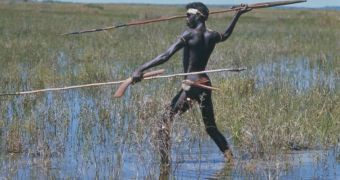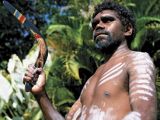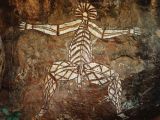The Australian Aborigines form together with the Bushmen and pygmies one of the oldest human race. They are one of the first human groups to have moved out of Africa perhaps 60,000 years ago. This group formed a race later known as Black Asians. 12,000 years ago, they were the main inhabitants of India, Indochina, Indonesia, New Guinea, Melanesia, and perhaps even eastern China. They make the most primitive form of this race, later types being represented by Papuans or Melanesians.
Unlike African Blacks, these people have abundant beards, a lot of hair on the body, are shorter, have slimmer lips, a tilted front (not cambered), prominent eye ridge and aquiline noses. The hair is somewhat less kinky. The Aborigines maintain in their physic some very primitive traits for modern human races: evasive foreheads, very prominent eyebrow ridge, eyes sunk into the sockets, and extremely wide noses, with a depressed base and elusive chin. The skin is dark, but not so much like in African Blacks; the body is rather slim and tall, with long and thin arms and feet.
This race has one of the highest genetic diversity amongst current human races (being bypassed just by the Bushmen, the oldest living human race), the mitochondrial DNA showing an age of at least 35,000 years for this human type.
One curiosity of the Black Asian race (Aborigines included) is that some children can have naturally blond hair. Still, with the age this hair turns gradually dark.
But later than 12,000 years ago, in India entered White populations from central and southwestern Asia, greatly displacing or mixing with this race. Still, even today, many Indian populations, especially in the south, still preserve this Black Asian racial type, and some Gurus from the south cannot be distinguished from a Papuan or Australian Aborigine. In southeastern Asia, they were replaced by Mongoloids coming from Tibet and central China.
Australian Aborigines could have entered Australia through New Guinea about 40,000 years ago, as during the peak of the last Ice Age New Guinea was connected to the Australian continent via a land bridge, forming the called Sahul.
When European colonization started, Aborigines retreated to the inner deserts and steppes and to the remote north. The Aborigine culture is one of the Paleolithic (Old Stone Age), a glimpse of how we lived more than 20,000 years ago.
Aborigines made from stone their knives, axes and adzes. The technology for making these stone tools involved hitting one stone against another, till making them bounce required chips, which were slowly given the shape of the desired object; once achieved, their surface was polished by rubbing it against a tough object. The wooden handle was attached using a glue made of resin and secured further with fibers.
The most common weapon used by Aborigines was a short wooden spear with a stone tip. The most curious weapon was the boomerang, used for hunting rapid animals and birds, while for hunting emu or bush turkeys was employed the spear. The boomerang has the property to return to its launcher if missing the target. Axes and adzes were used for cutting branches and trees, or for making passage amongst spiny bushes, while the knives were used for cutting the meat of the hunted animals.
Because Aborigines lacked any contact with other cultures, their own is poor: they do not know pottery, weaving, metals and even more basic elements like the bow and arrows or hunting traps.
Their dwellings are one of the most primitive on Earth, mere shelters made of two stakes finishing on a pitchfork and fixed on the soil at a distance of 3 m (10 ft) one from another. These sticks sustain another horizontal layer, against which is leaned a wall made of branches and leafs which protects the family against the wind. Sometimes a type of tree bark was added. In the front of the hut a bonfire was set, for cooking and heating the sleeping people during the night, also chasing away the dangerous animals. When the cold was intense, a bonfire was set close to each sleeping member of the group, and one person watched over the fire not to wane.
Today, most Aborigines have adapted to the western lifestyle, working mostly as herders in the inner grassland areas of Australia. Still, some groups maintain a more or less traditional lifestyle.
Aborigines make painting over tree bark, representing stylized animals (kangaroos, emu, snakes, birds and others) in various attitudes. Sometimes their paintings are complicated, depicting scenes of their legends and myths. In the inner Australia, there are also rock paintings, very similar in style to those found from the Paleolithic of France, Spain and Sahara. In fact, the Cro-Magnon people of the Ice Age Europe are believed to have been an Aborigine type.
Even if Aborigines usually went naked, they adorned with "tattoos", smeared their hair (usually long) with mud, and inserted large feather headdresses in it. Sometimes, they wore false beards made of feathers or fibers.
In the Aborigine group, children receive special care, receiving the best food, a lot of affection and not being punished for their pranks. Children stay with the women, helping them in gathering berries, seeds and small animals (insects included).
When the boy reaches 10-12 years of age, he will pass through a series of ceremonies: his body is tattooed and painted and he is taught legends and customs of the tribe, he learns to hunt, and he is submitted to a series of physical probes meant to fortify him. This learning period can last years, and when considered adult, he could marry.
The most important festivity of the Aborigines is the corroborri. The men adorn themselves with feather headdresses, imitating the look of the totem animal of the tribe. The magic ceremony has as a final purpose the achievement of the favor of the spirits of the animals which the Aborigines wanted to hunt so that they came in the reach of their weapons. By mimicking animals' movements, Aborigines took over the spirits of the animals forcing them to accomplish their will.
The corroborri dance is accompanied by the singing and the rhythmic beating of wood pieces: the rhythm and velocity grew gradually till the dancers fell exhausted to the ground.
One characteristic of the Aborigines is that they have the same mobility in the big toe like in the thumb. This way they could grab small objects from the soil with their feet, fuel the fire or take a spear from the ground without the need for bending down.
This was useful for climbing trees for collecting bee hives (one of their delicacies), especially as Australian bees use to make their nests in smooth and branch free trees. Unlike other humans, which advance in the trees by moving one arm or feet at a time, the Aborigines made jumps on the tree trunk with both hands or both feet at the same time. This property gives them jobs as wood cutters.
The Aborigines of the northern Australia fish using one-trunk made boats. The trunk is carved in a very primitive way. For fishing, Aborigines use harpoons ending in pitchforks made of wood hardened on fire. Using this harpoon, they hunt even large sharks, which, after being wounded with the harpoon, they are approached and finished with heavy stone axes.
In rivers and lakes, fishing nets are employed. Like the Indians of the Amazon, Aborigines can use the method of poisoning the shallow waters, the dizzy fish being collected with nets or baskets.
Aborigine men usually went to hunt in group. Even when going to hunt alone, the hunter had to share the game with the rest of the group. The Australian fauna is original, but poor, and Aborigines had to content from possums to kangaroos and emus. Usually, they do not hunt dangerous animals, except the crocodile. The hunter knew by the traces the species and the age of the trace. Aborigines looked for filtering how much they could close to the large prey (like kangaroos) to a distance that allowed them to kill with the spear. Sometimes the hunters smeared their body with clay for camouflaging during the hunt. The presence of termite mounds eased the task of getting closer.
They also organized collective hunts, involving women too. When encountering a kangaroo group, a few men together with the women herded the animals through screams and gestures to a certain direction where skilled hunters stalked in hidden places. When the animals were in their reach, they went out of their hidings, throwing their spears.
Another method involved fencing an area from three sides with twigs and branches, while the kangaroo group was herded through the free side. Inside the place, Aborigines could also dig holes covered by twigs that trapped the animals. Like Bushmen and pygmies, Aborigines can also practice a very old hunt: the chase.
Even if the hunt is exhausting, and the Aborigines are eager to eat, they never consume raw meat. Small mammals and birds are cooked unskinned, with bowels intact. They are put on embers, hot stones or sand, while large animals are cut in large pieces and the meat cooked on fire. Sometimes, the bowels were put out through a cut made into the abdomen, and inside hot boulders were introduced, so that the meat cooked also from the interior. As the game is not skinned, the roasted meat remained juicy.
In many places, the animal filled with hot stones was put on holes containing amber, being wrapped in leaves and soil. In 2-3 hours, the dinner was ready.

 14 DAY TRIAL //
14 DAY TRIAL // 

